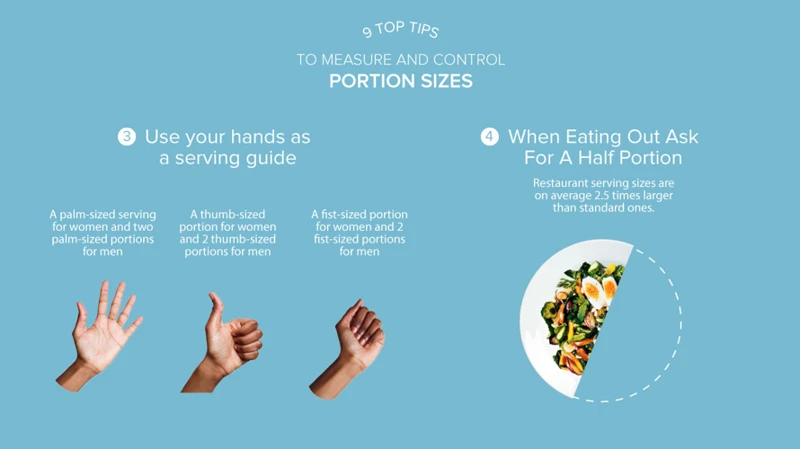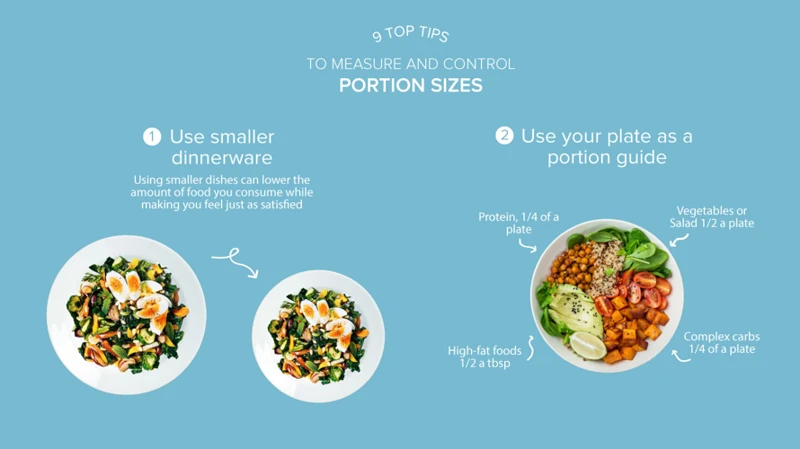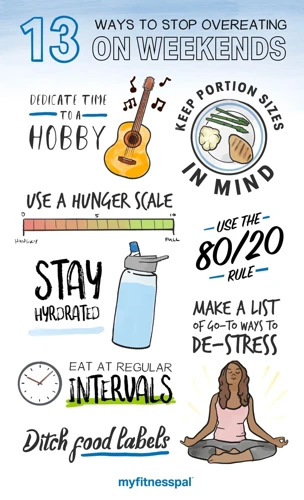Have you ever found yourself staring at an overwhelmingly large plate of food at a restaurant, wondering how you could possibly finish it all? The portion sizes at many restaurants can be quite excessive, leaving us feeling uncomfortably full and struggling with our weight management goals. But don’t worry, there are simple strategies you can use to reduce your portion sizes when eating out. In this article, we will explore seven practical tips that will help you control your portions and enjoy your meal without overeating. So, let’s delve into these strategies and learn how we can take charge of our restaurant experiences to maintain a healthy lifestyle.
Use Your Hands to Measure Portions

When trying to reduce portion sizes, it can be difficult to know exactly how much food to eat. However, there is a simple solution that can be used anywhere, including restaurants: using your hands as a guide. By visually measuring food portions with the size of your hand, you can better control how much you eat and avoid overindulging. Here are a few strategies for using your hands as a measuring tool.
1. Use Your Hand as a Guide
One simple strategy for reducing portion sizes at restaurants is to use your hand as a guide. This is a handy and immediately available tool that you can use to estimate serving sizes. Below is a table that illustrates how you can use your hand to measure different types of food groups.
| Food Group | Portion Size | Hand Guide |
|---|---|---|
| Protein (meat, fish, tofu) | 3 oz | Palm of your hand (excluding fingers) |
| Vegetables | 1 cup | Two hands cupped together |
| Carbohydrates (rice, pasta, potatoes) | 1/2 cup | One cupped hand |
| Fats (nut butter, cheese) | 1 oz | One thumb |
Using your hand as a guide can help you avoid overeating by giving you a rough idea of how much food you should be consuming. For example, if the serving of meat you are served is larger than the palm of your hand, it’s probably too much. Similarly, if the amount of pasta on your plate exceeds the size of a cupped hand, you may want to consider cutting back on the portion size. Using your hand as a guide is a simple and effective way to manage your portion sizes while dining out.
2. Use Smaller Plates and Bowls
One effective strategy for reducing portion sizes at restaurants is to use smaller plates and bowls. When we are served larger portions on bigger plates, we tend to eat more without even realizing it. However, by choosing smaller plates and bowls, we can trick our minds into thinking that we’re eating a full portion even when it’s actually smaller. Here are some tips on how to implement this strategy:
- When ordering, ask the server if the restaurant offers smaller plates or bowls. This can sometimes be a great way to control your portions while still enjoying your favorite meals.
- If smaller plates or bowls are not an option, try to choose the smallest plate or bowl available. You can also ask the server to bring you a salad plate instead of a dinner plate.
- Another option is to use your hand as a guide for portion sizes. For example, one serving of protein should be about the size of your palm, and one serving of carbohydrates should be about the size of your fist.
Using smaller plates and bowls can be an effective way to reduce portion sizes and avoid overeating at restaurants. Don’t be afraid to ask for a smaller plate or to use your hand as a guide for portion sizes. With practice and patience, you can develop a better understanding of appropriate portion sizes and learn to make healthier choices when dining out.
Be Mindful When Ordering

When eating out at restaurants, it can be tempting to indulge in large portions and decadent dishes. However, being mindful of your choices can help you make healthier decisions and stick to your goals. By taking a few simple steps and making conscious choices, you can enjoy your dining experience without overdoing it. Here are some strategies to keep in mind when ordering at restaurants.
3. Scan the Menu for Healthy Options
When you’re trying to reduce portion sizes at restaurants, it’s important to be mindful of what you’re ordering. One strategy for doing this is to scan the menu for healthy options. Here are some tips for doing so:
- Look for dishes with lean protein: Choose dishes that are centered around lean sources of protein, such as grilled chicken, fish, or tofu. Avoid dishes that are high in saturated fat, like those with creamy sauces or fried meats.
- Choose dishes with lots of vegetables: Opt for dishes that are packed with vegetables, preferably steamed, roasted or grilled. Vegetable-packed dishes provide lots of nutrients and fiber in proportion to their calorie content, so you can eat more of them for fewer calories.
- Avoid dishes with added sugars: Be aware of added sugars, which can significantly boost calorie counts. Avoid dishes that are topped with sugary sauces, dressings, or toppings, and choose dishes that are naturally sweetened with fruits or vegetables instead.
- Be wary of “healthy” menu items: Some restaurants may label certain items as “healthy” or “light,” but these designations can be misleading. Be sure to check the nutrition information before ordering to make sure that the dish is actually a healthy choice.
By scanning the menu for healthy options, you’ll be better equipped to make smart choices when ordering at a restaurant.
4. Order First and Stick to It
When dining out at a restaurant, it can be difficult to resist the temptation of indulging in the large menu options. However, engaging in strategies to reduce portion sizes can lead to a healthier lifestyle. One such strategy is to order first and stick to it. Allow yourself to take a few minutes to scan the menu for healthier options and make your decision before anyone else orders. By doing so, you are less likely to be influenced by the choices made by others at the table.
It can be helpful to narrow down your choices to a few healthy options before arriving at the restaurant. A great way to do this is by researching the menu online beforehand. This way, you know what options to look for when you arrive and can make a well-informed decision.
Another way to help you stick to your order is by informing the waiter or waitress of your decision before anyone has ordered. This can help relieve the pressure of making a choice on the spot, and also makes it clear to others at the table that you are sticking to your plan.
Below is a table summarizing the steps for successfully ordering first and sticking to your decision:
| Step | Description |
|---|---|
| 1 | Research the menu beforehand to narrow down healthy options |
| 2 | Take a few minutes to scan the menu before anyone else orders |
| 3 | Inform the waiter or waitress of your decision before others order to relieve pressure and commit to your choice |
By following these steps, you can confidently make healthy choices and stick to them when dining out at a restaurant.
5. Ask for Half Portions or a To-Go Box
One strategy that can really help you reduce your portion sizes at restaurants is to ask for half portions or a to-go box. This can be especially helpful if you know that the restaurant serves particularly large portions. Here’s how you can use this strategy:
- Know Your Limits: Before you even order, take a moment to think about how much food you really need to feel satisfied. If you’re not sure, consider a couple of factors, like how hungry you are, how much you’ve eaten earlier in the day, and whether you just want a taste of something or a full meal.
- Order Carefully: Once you’ve decided what you want to eat, make your order and then ask your server if it’s possible to get a smaller portion. Depending on the restaurant, they might be able to accommodate your request. If not, ask if they can pack up half of the dish for you to take home in a to-go box.
- Stick to Your Plan: If you do decide to order a smaller portion or take a to-go box, make sure you actually follow through with your plan. It can be tempting to keep eating, especially if the food is delicious, but remember that you already decided on your limits before you started eating.
- Enjoy Your Leftovers: If you do end up taking a to-go box home, don’t just leave it in your fridge to go bad. Make sure you eat it within a day or two, and savor it as a special treat for yourself.
By asking for half portions or taking to-go boxes, you’ll be able to enjoy your restaurant meals without overeating or wasting food. So, next time you’re dining out, give this strategy a try and see how it works for you!
Control Your Environment
Now that we’ve covered strategies for measuring portion sizes and being mindful when ordering, it’s time to take a look at how you can control your environment to avoid overeating at restaurants. This is an important step because sometimes it can be difficult to stick to your goals when you’re surrounded by temptations. Here are a few tips that can help you stay on track and eat healthily even when dining out.
6. Avoid All-You-Can-Eat Buffets
Avoiding All-You-Can-Eat Buffets can be an effective way to reduce portion sizes when eating out. At these types of restaurants, it can be tempting to keep going back for more food, even if you are already full. Here are some reasons why you should consider avoiding all-you-can-eat buffets:
| Reason | Explanation |
| Unlimited food | At all-you-can-eat buffets, there is no limit to how much food you can consume, which can lead to overeating and ultimately, weight gain. |
| Minimal control over portions | Since you serve yourself, it can be challenging to accurately measure the appropriate portion sizes for your meal. |
| Large variety of options | Having a large range of options to choose from can stimulate your appetite and cause you to eat more than you would have ordinarily. |
| Unhealthy options | All-you-can-eat buffets often provide a vast number of unhealthy options that are high in calories, fat, and sodium, which can be detrimental to your overall well-being. |
All in all, it is best to avoid all-you-can-eat buffets if you are trying to reduce your portion sizes and control what you eat when dining out. Opt for healthier restaurants that provide options that are better for your overall health and well-being.
7. Ask for Dressings and Sauces on the Side
One of the easiest ways to reduce portion sizes and calorie intake when dining out is by asking for dressings and sauces on the side. Many dressings and sauces are high in calories and fat, and restaurants tend to be generous with the portions they serve. By asking for them on the side, you have more control over the amount you consume.
Here are some tips for effectively asking for dressings and sauces on the side:
- Be specific: When placing your order, clearly state that you would like your dressing or sauce on the side.
- Use keywords: Emphasize that you want your dish “lightly dressed” or “lightly sauced” to ensure that the chef doesn’t overdo it.
- Measure it out: Once you receive your dish, use a measuring spoon or cup to portion out the dressing or sauce yourself.
- Dip it: Instead of pouring the entire side of dressing on your salad, dip your fork in the dressing before each bite. This will help control the amount you consume.
- Take it to-go: If you end up not using all of the dressing or sauce, consider taking it home with you for later use.
Making a simple request for your dressing or sauce on the side can make a big difference in reducing the amount you eat at restaurants. By following these tips, you can ensure that you are in control of what you consume and maintain a healthy diet.
Conclusion
In conclusion, these simple strategies can help you reduce portion sizes when dining out at restaurants. By using your hands as a guide, choosing smaller plates and bowls, and being mindful when ordering, you can easily control your portions. Scanning the menu for healthy options, ordering first and sticking to your choice, and asking for half portions or a to-go box can also help you stay on track with your portion sizes. Additionally, avoiding all-you-can-eat buffets and asking for dressings and sauces on the side are effective ways to control your environment and keep your portions in check. Remember, reducing portion sizes is not about depriving yourself of what you love to eat, but rather about finding a healthy balance that works for you. By practicing these strategies, you can enjoy delicious meals while still maintaining a healthy lifestyle. So next time you head out to a restaurant, keep these tips in mind and feel confident in your ability to control your portion sizes.
Frequently Asked Questions
How can I use my hands to measure portions?
Use your hand as a guide for portion sizes. For example, one serving of protein should be about the size of the palm of your hand.
Why should I use smaller plates and bowls?
Smaller plates and bowls can trick your brain into thinking you’re eating a full portion when you’re actually consuming less food.
How can I be mindful when ordering at a restaurant?
Scan the menu for healthier options and stick to your decision by ordering first. You can also ask for half portions or a to-go box to control your portion sizes.
What are some healthier options to look for on a restaurant menu?
Look for dishes with lean protein, vegetables, and whole grains. Avoid items that are fried or smothered in sauces.
Why should I order first at a restaurant?
Ordering first can help you stick to your initial decision and avoid being influenced by what your dining companions are ordering.
How can I reduce portion sizes if I’m at an all-you-can-eat buffet?
Avoid all-you-can-eat buffets altogether or make a plan beforehand to only consume a certain amount of food. You can also take small portions and eat slowly to feel satisfied without overeating.
Why should I ask for dressings and sauces on the side?
Dressings and sauces can be high in calories and fat, so by asking for them on the side, you can control the amount that goes onto your food.
What should I do with leftovers at a restaurant?
Ask for a to-go box and bring the leftovers home for another meal. This can also help you control your portion sizes while dining out.
How can I make sure I’m not overeating due to emotional reasons?
Check in with yourself before and during the meal to understand if you’re eating out of hunger or another emotion. Take your time while eating and listen to your body’s hunger and fullness signals.
Is it okay to indulge in a larger portion size occasionally?
Yes, it’s okay to indulge in a larger portion size occasionally. The key is to practice portion control regularly and make healthier choices most of the time.







